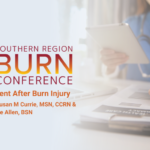Abstract | December 20, 2021
Pain Management after Burn Injury
Learning Objectives
- Describe evidence-based strategies to treat pain and anxiety.
- Associate haw pain and anxiety affect wound healing.
- Compare pharmacologic and no-pharmacologic approaches to allay pain and anxiety.
- Correlate how comorbidities affect pain and anxiety.
Introduction:
Management of pain and anxiety is the foundation for wound healing, sleep, participation in activities of daily living and rehabilitation therapy, quality of life and an accelerated recovery. Burn pain is widely considered the most painful injury a person can sustain. Therapies necessary to treat burns intensify pain making pain and anxiety control more difficult. Unfortunately, management of burn pain is frequently based on personal bias, tradition, or institutional preference. Aggressive pain and anxiety management coupled with appropriate wound management minimize negative pain influences and maximize recovery, both physical and psychological. The American Burn Association (ABA) published an evidence-based guideline for treatment of burn pain in 2020, however it did not address many of the comorbidities seen in our burn patients that compound pain management. Pain is multidimensional and it is necessary to address cultural/ethnic factors, age, history of drug and alcohol abuse, mental illness, obesity, and chronic pain.
Methods:
This lecture reviews the ABA multimodal approach to pain by illustrating pharmacological aspects of each medication including onset, peak, duration, synergism and timing of administration. Most importantly, an exploration in the literature regarding pain and mental illness i.e., schizophrenia, bipolar, depression and anxiety disorders. How burn patients with drug, alcohol abuse and chronic pain perceive pain and pain management solutions. Considerations for patients who are obese and elderly are addressed especially related to metabolism and pharmacokinetics. Lastly, a review of novel therapies such as virtual reality, nitrous oxide, relaxation techniques, desensitization, distraction and mobility.
Conclusion:
The goal of this lecture is to realize that pain perception is multifactorial and requires a multimodal approach that includes tailoring the pain regimen to the individual burn patient.

